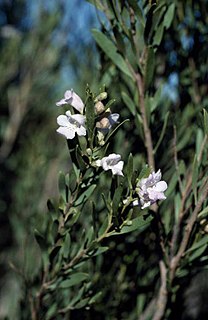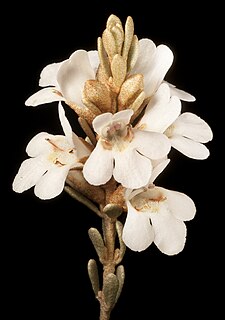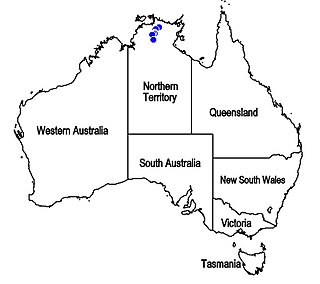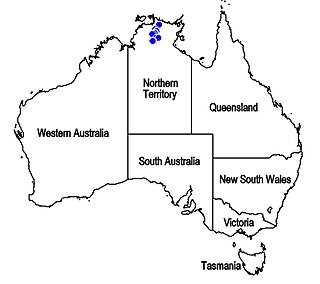
Eremophila paisleyi is a plant in the figwort family, Scrophulariaceae and is endemic to Australia. It is a rounded, broom-shaped shrub with white or lilac-coloured flowers which occurs in Western Australia, South Australia and the Northern Territory.
Eremophila virens, commonly known as green-flowered eremophila or Campion eremophila, is a flowering plant in the figwort family, Scrophulariaceae and is endemic to Western Australia. It is an erect shrub with large, shiny leaves and hairy, yellowish-green flowers.
Dasymalla chorisepala is a flowering plant in the mint family Lamiaceae and is endemic to Western Australia and the Northern Territory. It is a small shrub with its branches and leaves densely covered with hairs. The leaves are stalkless, egg-shaped and covered with yellowish hairs while the flowers are small, tube-shaped and white.
Dasymalla glutinosa is a flowering plant in the mint family Lamiaceae and is endemic to Western Australia. It is a spreading, sticky shrub with glabrous branches, egg-shaped, stalkless leaves and small, white or cream-coloured, tube-shaped flowers.
Dasymalla teckiana is a flowering plant in the mint family Lamiaceae and is endemic to Western Australia. It is a small, openly branched, sticky shrub with mauve and white, bugle-shaped flowers.

Pityrodia loricata is a flowering plant in the mint family Lamiaceae and is endemic to Australia. It is a dense, greyish, multi-stemmed shrub with whorled leaves, prominent sepals and pale, pinkish-white flowers. It is common in Western Australia and the Northern Territory and there is a single record from South Australia.

Muniria quadrangulata is a flowering plant in the mint family Lamiaceae and is endemic to Arnhem Land in the Northern Territory. It is a shrub with its branches and leaves covered with a thick layer of woolly hairs and pale yellow flowers in groups of up to nine, surrounded by woolly hairs.

Pityrodia lepidota is a flowering plant in the mint family Lamiaceae and is endemic to the south-west of Western Australia. It is a small, densely-branched shrub with small leaves and whitish, bell-shaped flowers. The entire plant, apart from the petals, is densely covered with small, circular scales.

Pityrodia byrnesii is a flowering plant in the mint family Lamiaceae and is endemic to Arnhem Land in the Northern Territory. It is a shrub with hairy, glandular stems, stalkless, flat leaves and fragrant, off-white, bell-like flowers with purple stripes inside the tube.
Muniria angustisepala is a flowering plant in the mint family Lamiaceae and is endemic to the Northern Territory. It is an erect shrub with softly hairy, warty leaves and pale yellow, woolly flowers.
Muniria lanceolata is a flowering plant in the mint family Lamiaceae and is endemic to Arnhem Land in the Northern Territory. It is a shrub with its branches and leaves densely covered with a layer of short, greyish, branched hairs and red flowers near the ends of the branches.

Pityrodia chrysocalyx is a flowering plant in the mint family Lamiaceae and is endemic to the south-west of Western Australia. It is an erect, bushy shrub with small, glossy leaves, and flowers with white petals and a golden-yellow calyx.
Muniria megalophylla is a flowering plant in the mint family Lamiaceae and is endemic to Arnhem Land in the Northern Territory. It is a shrub with its branches and leaves densely covered with a layer of short, greyish, branched hairs and small groups of reddish-pink flowers near the ends of the branches.

Pityrodia gilruthiana is a flowering plant in the mint family Lamiaceae and is endemic to Arnhem Land in the Northern Territory. It is a dark green, spreading shrub with sticky, glandular branches and leaves and fragrant, off-white, bell-like flowers with purple stripes on the end.

Pityrodia iphthima is a flowering plant in the mint family Lamiaceae and is endemic to a small area in Western Australia. It is a small shrub with its branches, leaves and some of its flower parts densely covered with matted hairs. It has spike-like groups of up to forty flowers on the ends of the branches, the flowers tube-shaped, deep lilac and white, with brown spots inside.

Pityrodia salvifolia is a flowering plant in the mint family Lamiaceae and is endemic to Queensland. It is an erect, spreading shrub with aromatic, wrinkled or corrugated leaves and clusters of small flowers with white petals. It is mostly found in wet forests in coastal north Queensland.

Pityrodia lanuginosa is a flowering plant in the mint family Lamiaceae and is endemic to Arnhem Land in the Northern Territory. It is a woolly, spreading shrub with its leaves arranged in four rows and off-white, bell-like flowers with dark purple streaks.

Pityrodia obliqua is a flowering plant in the mint family Lamiaceae and is endemic to the Kimberley region of Western Australia. It is an erect shrub with hairy stems, wrinkled, egg-shaped leaves and pink, bell-like flowers with purple streaks inside.

Pityrodia puberula is a flowering plant in the mint family Lamiaceae and is endemic to Arnhem Land in the Northern Territory. It is a straggling shrub with narrow, hairy leaves arranged in four rows and off-white, bell-like flowers with dark purple streaks.

Pityrodia pungens is a flowering plant in the mint family Lamiaceae and is endemic to the northern part of the Northern Territory. It is an erect, spreading shrub with narrow, prickly leaves and off-white, bell-like flowers with dark purple streaks.













